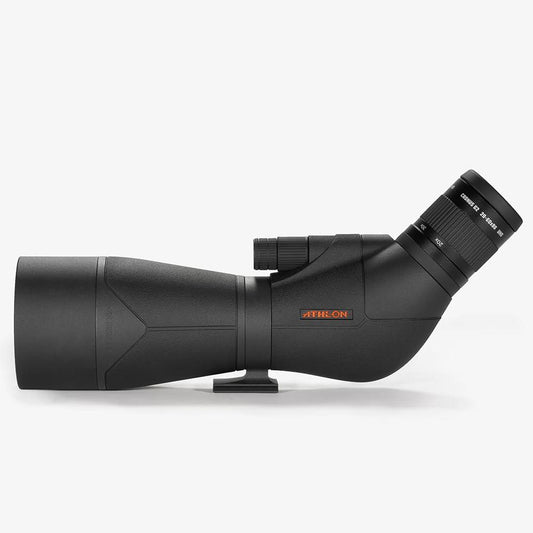

Athlon Cronus G2 UHD Dual Focus Spotting Scope 20-60x86mm Black features advanced ED glass technology that minimizes chromatic aberration and provides stunning clarity in various lighting conditions. The dual focusing system facilitates quick coarse adjustments and precise fine-tuning, making it suitable for birdwatching, hunting, or any outdoor observation. With a magnification range of 20-60x and an 86mm objective lens, this scope ensures excellent performance for spotting distant details with remarkable accuracy.
Designed for durability, the Cronus G2 is both waterproof and fog-proof, making it reliable in all weather scenarios. Its lightweight construction enhances portability, while the comfortable eye relief allows for extended viewing without discomfort. Whether you're at a shooting range or exploring nature, this spotting scope enhances your outdoor experience by delivering sharp, high-definition visuals.
Features:
- DUAL FOCUSING SYSTEM for quick coarse adjustments and precise fine-tuning.
- ERADICATED CHROMATIC ABERRATION ensures sharp, clear images in varying light conditions.
- ED GLASS provides vivid colors and high contrast for an immersive viewing experience.
- WATERPROOF AND FOG-PROOF construction, keeping your scope functional in all weather scenarios.
- HIGH MAGNIFICATION range of 20-60x lets you explore distant landscapes with ease.
- STURDY TRIPOD MOUNT compatibility for stable viewing during extended periods.
- LIGHTWEIGHT DESIGN for easy transport without sacrificing durability.
- COMFORTABLE EYE RELIEF allows for extended viewing without strain.
Technical Specifications Table
| Magnification | 20-60x |
|---|---|
| Lens Diameter | 86mm |
| Weight | 4.8 lbs |
| Dimensions | 20.5 x 5.5 x 5.5 inches |
| Material | Aluminum |
What’s in the Box?
- Spotting Scope
- Lens Covers
- Padded Carrying Case
- Neck Strap
Customer Reviews
"Absolutely the best spotting scope I've ever owned! The clarity is just fantastic." - John D.
"Perfect for my birdwatching trips. The dual focus feature is a game changer!" - Sarah K.
FAQ
How does the Athlon Cronus G2 UHD perform in low-light conditions? Thanks to its premium ED glass and advanced optics, this scope excels at both dusk and dawn, providing clear images even in challenging lighting. Users frequently note its exceptional visibility during these times.
What kind of maintenance is required for this spotting scope? Maintaining the Cronus G2 is simple; use a microfiber cloth to clean the lenses and store it in the padded case when not in use. In comparison to other models, its dual focusing system offers versatility that many competitors lack, enhancing user satisfaction.
Similar Models
Looking for more exceptional optics? Discover our extensive Athlon lineup, including models like the Athlon Ares G2 20-60x85 for added size and enhanced performance, or the Athlon Talos 20-60x80 for a budget-friendly option without compromising quality. Explore our full collection for superior spotting scopes tailored to your outdoor adventures.
You May Also Like
Here’s some of our most similar products people are buying. Click to discover trending style.






